| Franz Von Stuck
The Art History Archive - Symbolism
German Symbolist Painter
Born February 24th 1863.
Franz Von Stuck was am influential German Symbolist/Art Nouveau painter, sculptor, engraver, and architect born at Tettenweis near Griesbach in Lower Bavaria, Germany, the son of a miller. He was noted for his treatment of erotic and comic aspects of mythological themes. As a child he quickly became a gifted caricaturist. From 1878 to 1881 he attended the Kunstgewerbeschule in Munich, where he received particular encouragement from Ferdinand Barth (1842–92). Von Stuck attended the Munich School for the Applied Arts after secondary school, transferring in 1881 to the "Königliche Akademie der bildenden Künste" (Royal Academy for the Fine Arts). The drawings he did for the portfolio 'Allegorien und Embleme' ('Allegories and Emblems'), published by Gerlach and Schenk in Vienna, made his reputation as an outstanding draughtsman as early as 1882.
Around 1890, Von Stuck turned to sculpture and produced a number of statues and statuettes. The first major work was the Wounded Centaur in 1890, then the Athlete in 1892. At the 1893 'Munich Secession' exhibition (Von Stuck was a founder member) he showed "Die Sünde" (The Sin), creating a sensation. When only thirty-two, he was appointed professor at the Munich Academy in 1895. His notable students included Paul Klee, Hans Purrmann, Wassily Kandinsky, and Josef Albers. Von Stuck also became a member of the board of 'Genossenschaft Pan', publishers of the art magazine 'Pan', for which he designed the cover. In 1897 construction work began in Munich on the Villa Stuck in Prinzregentenstraße. The artist himself designed the architecture, the interior decoration and the furnishings for it and the ensemble amounted to one of the major total works of art of its day.
Stuck's subject matter was primarily drawn from mythology, inspired by the work of Arnold Böcklin. Large, heavy forms dominate most of his paintings and point toward his proclivities for sculpture. His seductive female nudes, in the role of the femme fatale, are a prime example of popular Symbolist content. Stuck paid close attention to the frames for his paintings and generally designed them himself with such careful use of panels, gilt carving and inscriptions that the frames must be taken as an integral part of the overall piece.
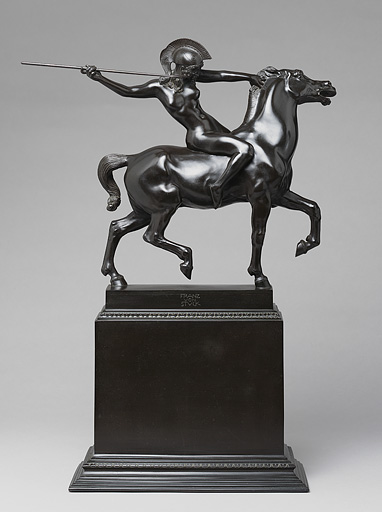
Franz Von Stuck - The Amazon - 1897 The many other prizes and honours awarded to Stuck included the Ritterkreuz des Verdienstordens der Bayerischen Krone (Cross of Knighthood in the Order of Merit of the Bavarian Crown), a distinction coupled with elevation to knighthood. In the last phase of his work, Von Stuck concentrated once more primarily on sculpture. The recipient of so many distinctions and an honorary member of numerous European academies, died in Munich in 1928. He was buried at the Waldfriedhof in Munich and his wife Mary rests beside him. His villa at the Prinzregentenstrasse, Munich is now a art museum.
Paintings & Sculptures by Franz Von Stuck:
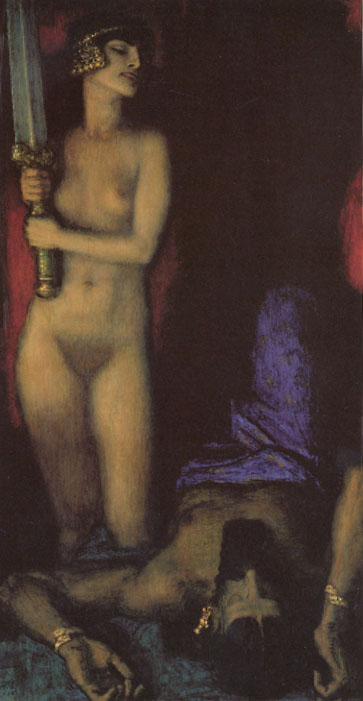
Works by Von Stuck (Date Unknown):
|
|
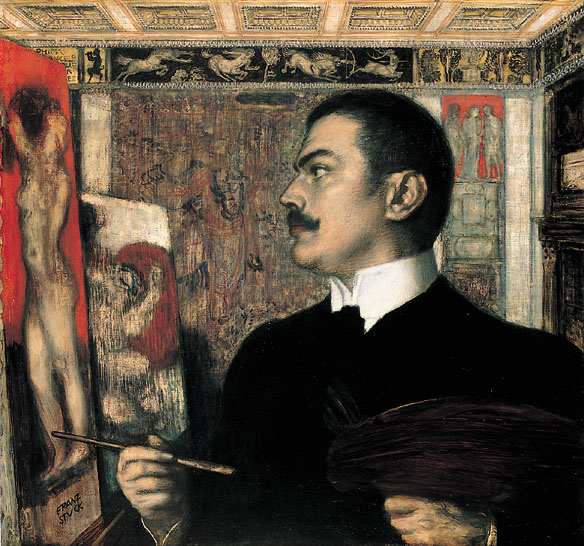
Franz Von Stuck: Living Images In the winter of 1965, local architect Hans Joachim Ziersch made a fascinating discovery in a Bogenhausen Villa he had bought for restoration. In the coal cellar of the bomb-damaged home, Ziersch found a basket stuffed with old photographs and sketches done on transparencies. The significance of the photographs lies in their ownership: the house being restored was the Villa Stuck, home of Munich artist Franz von Stuck from 1897 until his death in 1928. By January of 1968, the restoration was being completed in preparation for the Museum Villa Stuck's opening exhibit. In a corner of the basement, workers found a veritable treasure trove stuffed in a garbage can: 95 large-format photos, portrait studies and von Stuck's own building plans for the villa. The opening exhibition had already been planned and included a small number of the previously found photographs, but it was too late to include all but a small portion of the new find in the exhibit. In 1992, Jo-Anne Birnie Danzker, the new Villa Stuck director, began planning the current exhibit, but what had started out as a straightforward project turned into a massive research effort lasting three years. After the initial discovery, the von Stuck photographs were handed over to the Stadtmuseum. Birnie Danzker's staff eventually tracked down more than 1,000 von Stuck photographs from around the world; over 300 have been chosen for the exhibit. Von Stuck was mainly a painter of portraits in the Jugendstil prevalent in Munich at the turn of the century. His artistic career spanned roughly 40 years from his 1887 work as a caricature artist, to his professorship at the Munich Akademie (his students included Kandinsky and Klee), through his fame as one of Munich's best-known painters. Born in the Bavarian town of Tettenweis in 1863, von Stuck moved to Munich in 1878 for his art education and stayed here until his death of a heart attack in 1928. In 1897, he married Mary Lindpainter, the American widow of a Munich doctor, and began planning and building the villa. He lived there with his wife and daughter, Mary-born illegitimately to a baker's daughter in 1896-until his death. Familial relations had been on the decline before von Stuck's death, and his wife, who possibly suffered from cancer, died a short 12 months later. The distraught daughter abandoned the villa and its works, and the house remained part of the von Stuck estate until purchased in 1965. The current exhibit focuses on the influence and use of photography in von Stuck's work. He had a film developing laboratory in the villa's basement and most of the photographs exhibited were taken in the villa-many by von Stuck's wife. The photographs significant to the exhibit are the portraits von Stuck used as a base for his paintings, adding his own vision to produce paintings full of texture and subtlety. While many of von Stuck's portraits lack the individuality of a specific character and rely instead on the portrayal of an idealized image, von Stuck's paintings based on photos show a distinct combination of the subject's individuality with von Stuck's artistic idealization of the image. The exhibit's catalog, published in German by Munich's Prestel-Verlag and selling for DM 48, is amply and beautifully illustrated, documenting both von Stuck's life and his work. Like the exhibit itself, the catalog reveals that there was more to the man than his somber, strait-laced appearance might suggest. Many of the photos evince von Stuck's sense of humor, and the photos of him taken by his wife, Mary, are sometimes startlingly erotic. - The exhibit runs through July 7.
| |
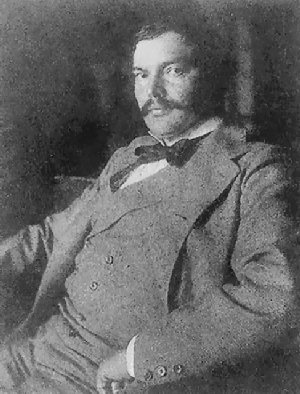
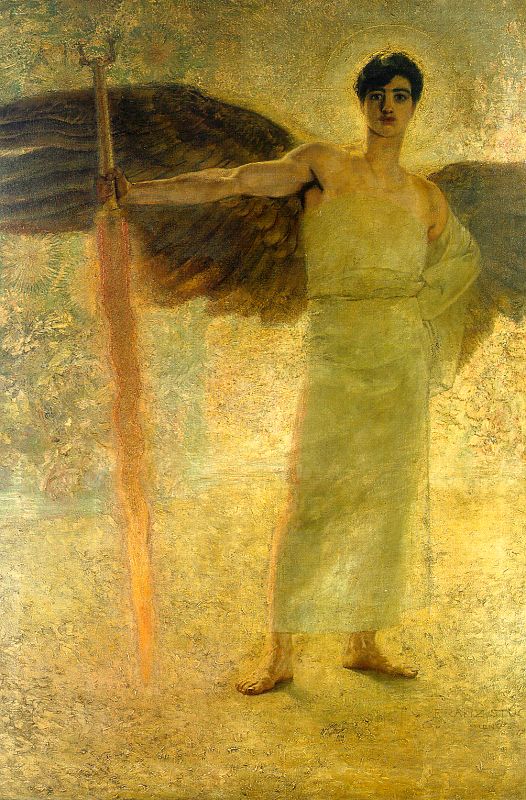 Awarded the gold medal for the painting "Die Wächter des Paradieses" ("The Guardians of Paradise) at the Annual Exhibition at the Munich Glass Palace in 1889, Von Stuck devoted himself entirely to painting, becoming a portraitist who was much in demand. His sitters' regal poses elevate them above the mundane, making them sublime and timeless. In addition to some early landscapes and numerous portraits, the painter's oeuvre is notable primarily for mythological and symbolic themes.
Awarded the gold medal for the painting "Die Wächter des Paradieses" ("The Guardians of Paradise) at the Annual Exhibition at the Munich Glass Palace in 1889, Von Stuck devoted himself entirely to painting, becoming a portraitist who was much in demand. His sitters' regal poses elevate them above the mundane, making them sublime and timeless. In addition to some early landscapes and numerous portraits, the painter's oeuvre is notable primarily for mythological and symbolic themes.
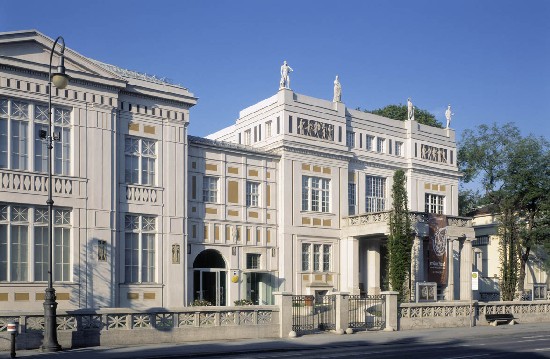 The building, with which Von Stuck, the 'prince of artists', erected as a monument to himself in the grand manner of the Renaissance, is acclaimed as a supreme achievement of its kind in architecture. The furnishings of the Villa were awarded a gold medal at the 1900 Paris Exhibition.
The building, with which Von Stuck, the 'prince of artists', erected as a monument to himself in the grand manner of the Renaissance, is acclaimed as a supreme achievement of its kind in architecture. The furnishings of the Villa were awarded a gold medal at the 1900 Paris Exhibition.
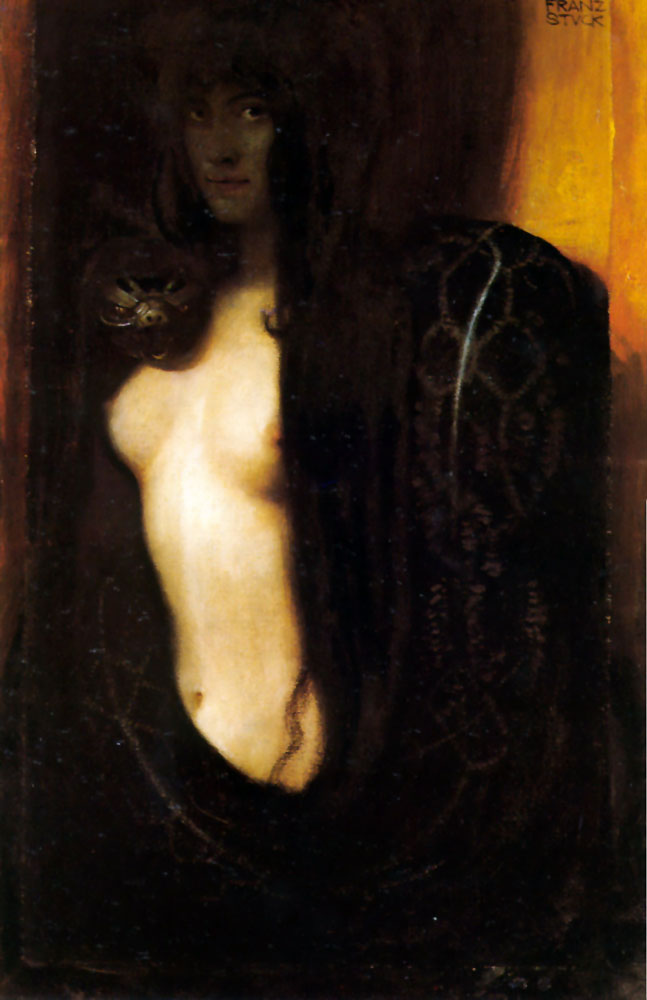 The number of Stuck's pupils who went on to great success served to enhance the teacher's own fame even further. Yet by the time of his death, Stuck's importance as an artist in his own right had almost been forgotten: his art seemed old-fashioned and irrelevant to a generation shattered by the First World War. Stuck generally remained lost to public memory until the late 1960s when a renewed interest in Art Nouveau brought him to attention once more. In 1968 the Villa Stuck was opened to the public; today it is a museum.
The number of Stuck's pupils who went on to great success served to enhance the teacher's own fame even further. Yet by the time of his death, Stuck's importance as an artist in his own right had almost been forgotten: his art seemed old-fashioned and irrelevant to a generation shattered by the First World War. Stuck generally remained lost to public memory until the late 1960s when a renewed interest in Art Nouveau brought him to attention once more. In 1968 the Villa Stuck was opened to the public; today it is a museum.